
Moving to a new home can be both exciting and overwhelming. If you are planning a relocation in Texas, you want a moving company that is reliable, efficient, and experienced. For residents looking for top-tier moving services, go to Laredo Movers, a trusted name in the industry. With their professional approach and dedication to customer satisfaction, they make the moving process seamless, reducing the stress and hassle often associated with relocation.
In addition to Laredo, those relocating to the Houston metropolitan area should consider Friendswood Movers. They specialize in providing tailored moving solutions that fit a variety of needs, from small apartment moves to large family relocations. Their team ensures that every item, from fragile household goods to bulky furniture, is handled with the utmost care, giving clients peace of mind during one of life’s most demanding tasks. By choosing experienced movers, you can focus on settling into your new home while leaving the logistics to the experts.
Why Choose Professional Movers
Many people underestimate the complexity of moving. Professional movers offer more than just transportation; they provide packing services, loading, unloading, and sometimes even temporary storage. By hiring experts like Laredo Movers and Friendswood Movers, you are not only ensuring the safety of your belongings but also saving significant time and energy. Their trained staff understands the best techniques for packing and transporting items securely, reducing the risk of damage or loss.
Additionally, moving companies have the right equipment to handle large or awkwardly shaped items. Whether it’s a grand piano, a bulky sofa, or delicate electronics, movers come prepared with dollies, ramps, and protective coverings. This equipment, combined with experience, ensures a smoother, faster, and safer relocation compared to a DIY move.
Insurance and Liability Coverage
One critical aspect of hiring professional movers is understanding insurance and liability coverage. Reputable moving companies offer protection plans that cover potential damage or loss during transit. This additional security provides peace of mind, knowing that your belongings are protected. It’s important to ask your movers about available coverage options and select a plan that suits your specific requirements. For further guidance on transportation safety and standards, the U.S. Maritime Administration provides valuable resources and regulations for safe transport at https://www.maritime.dot.gov/.
Planning Your Move Efficiently
Planning is key to a successful move. Start by making a checklist of tasks, including notifying utility companies, updating your address, and organizing your belongings. Communicate clearly with your moving company about what needs to be moved, any fragile items, and your preferred schedule. Professional movers like Laredo Movers and Friendswood Movers are used to working with detailed plans and can advise on timelines to ensure the move is completed efficiently.
Moreover, understanding the regulations and safety standards involved in moving can save you headaches. For instance, maritime and transportation guidelines often impact long-distance relocations or moves that involve shipping containers. For reliable information, you can refer to authoritative sources such as the U.S. Maritime Administration. Their website provides guidelines and best practices for safe and compliant transportation of goods, adding an extra layer of assurance for relocations involving significant logistics.
Cost Considerations
Many homeowners worry about the cost of hiring professional movers. While DIY moves may seem cheaper, they often come with hidden expenses such as rental trucks, fuel, packing materials, and potential damages. Hiring experienced movers offers a predictable cost structure, often including insurance coverage for added protection. Laredo Movers and Friendswood Movers provide transparent pricing, ensuring that there are no unexpected charges and that you receive the best value for your investment.
Customer Satisfaction and Reputation
The reputation of a moving company is often the best indicator of their reliability. Positive reviews, testimonials, and referrals reflect consistent performance and high customer satisfaction. Both Laredo Movers and Friendswood Movers have built strong reputations in their respective areas, thanks to professional staff, attention to detail, and commitment to providing stress-free moves. By choosing established movers, you can trust that your relocation will be handled with care and expertise.
Conclusion
Relocating doesn’t have to be a stressful experience. By partnering with trusted movers like Laredo Movers and Friendswood Movers, you ensure that your move is organized, efficient, and safe. From professional packing to careful transportation and storage solutions, these companies provide everything needed to make your transition seamless. Whether moving locally or long-distance, investing in expert moving services guarantees peace of mind and a smooth start in your new home. For reliable guidelines on transportation safety, visit the U.S. Maritime Administration for authoritative resources.


